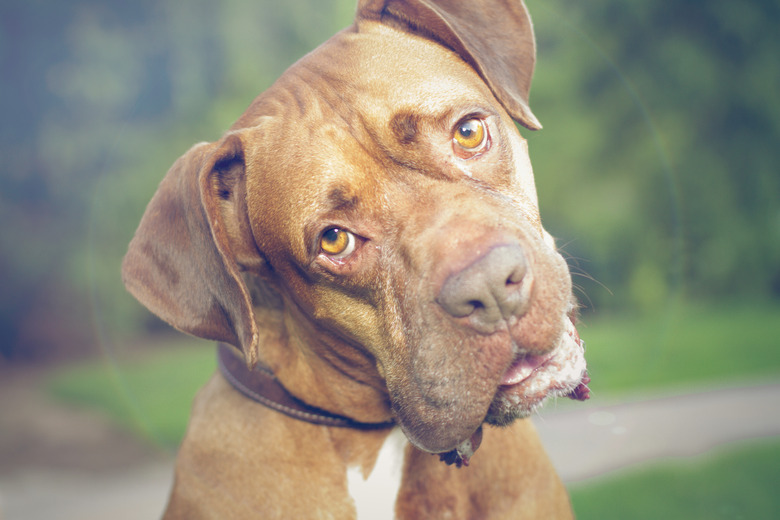Dry Skin Around A Dog's Eyes: Causes And Treatments
Dry Skin Around A Dog's Eyes
Dry skin or hair loss around your dog's eyes could be an allergy, a simple skin irritation, or an indication of a more serious medical condition. Diseases of a dog's skin, such as ringworm and mange, present with dry, patchy, or flaky skin and require veterinary attention. We spoke with Dr. Shagufta Mulla, a veterinarian with a DVM degree from Colorado State University with 20 years of experience as a small animal veterinarian, to find out more.
Ringworm infections near a dog's eyes
Ringworm infections near a dog's eyes
Ringworm is a fungal infection that can appear anywhere on your dog's body, though it's often more noticeable on the face because the hair is shorter. Ringworm looks like raised red welts with a red ring and a crusty, pale center. There may be obvious hair loss around the lesions, and the skin can look dry or scaly. Your dog may paw at their face to scratch the welts, which can result in spreading the infection to the forelimbs and feet.
If ringworm is diagnosed, the veterinarian will treat your dog with an anti-fungal medication and will sometimes prescribe antibiotics or cortisone ointments to stop itching and infection. If you suspect ringworm, do not handle your dog without gloves and protective clothing and keep them away from other pets until they have been treated.
Ringworm is zoonotic, meaning it can easily be transferred to humans and other animals and vice versa. "Young children, immunocompromised individuals, and older adults are more likely to contract ringworm," says Dr. Mulla.
Demodectic mange is a common skin condition in dogs
Demodectic mange is a common skin condition in dogs
Demodectic mange is a common parasitic skin infection most often seen in young dogs or dogs with immune system disorders. "It is caused by mites that are normally found in small numbers deep within a dog's hair follicles," says Dr. Mulla. Demodectic mange can cause patchy hair loss, appearing dry and sometimes raw. It is often found on the face and around the eyes.
Your veterinarian will collect samples from several affected areas by conducting skin scrapes to make a definitive diagnosis. If there are fewer than four skin lesions and the infection appears localized, your dog may be treated with a benzoyl peroxide shampoo. In more severe cases, an oral medication specific to your dog's age and medical history will be prescribed. "This may be used in the localized form, meaning four skin lesions or fewer," explains Dr. Mulla. "For cases with more than four lesions, called generalized demodicosis, there are various oral treatments that your veterinarian can choose from based on your dog's age and medical history."
Demodectic mange is not contagious to humans or other household pets. As with other skin irritations and conditions, a secondary bacterial infection can occur if the skin becomes infected. In this case, antibiotics may be necessary. "Demodectic mange is red mange," says Dr. Mulla. "A secondary infection in a dog with mange would likely be bacterial."\
Yeast infections on a dog's face
Yeast infections on a dog's face
A skin yeast infection may be responsible for the dry skin around your dog's eyes. The skin may appear greasy, and a musty, yeasty odor is often noticeable. Yeast infections are most commonly found in folds and creases in the skin, so your dog's eyelids may be most affected.
Yeast infections require veterinary attention. Your veterinarian may recommend using an anti-fungal medication or a shampoo or wash composed of benzoyl peroxide and sulfur/salicylate or chlorhexidine and ketoconazole to alleviate the condition. A dog's yeast infection cannot be transferred to humans.
Atopic dermatitis and dandruff around a dog's eyes
Atopic dermatitis and dandruff around a dog's eyes
Dogs with sensitivities to various indoor and outdoor allergens can develop atopic dermatitis, an allergic skin irritation. Skin can appear red, inflamed, or dry, and scabs may be present. Food allergies and reactions to fleas are common causes.
If the problem persists on the face and around the eyes and ears, dogs may scratch and paw to stop the itching that accompanies the condition. This can lead to scratches and abrasions, which can cause a secondary infection if left untreated.
Your veterinarian will try to identify the cause of the problem and may suggest a radioallergosorbent blood test, which can be used to determine specific allergens. Treatment for your dog may include allergy medications, antihistamines, anti-itch creams, or prescription dog food.
The bottom line
The bottom line
Dry, scaly skin around a dog's eyes has many common causes, such as ringworm, demodectic mange, yeast infection, or allergic reactions. These infections can be uncomfortable and can cause itchiness. Some skin problems may spread to other parts of the dog's body. There are skin disorders in dogs that can be transferred to humans and other animals. Always seek veterinary care to discuss treatment options if you notice dry, red, or itchy skin around your dog's eyes.


